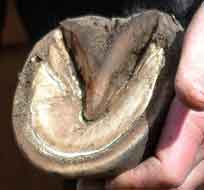Most of the problems we see in the hooves of domestic horses are related to flaring of the hoof wall.
- -- transition pain is due to flaring which
allows the coffin bone to settle down and bruise the sole corium;
- -- founder is essentially a flare, most often a forward toe flare;
- -- contracted heels are due to a forward-flared toe;
- -- navicular pain is related to a forward-flared
toe causing the foot to land toe-first.
Other than laminitis, in which inflammation of
the laminae makes the white line stretchy, flares are the
result of incorrect mechanical forces which force the wall away from
the coffin bone.
What is a flare?
A flare is separation of the hoof wall, away from the coffin (pedal) bone. Sometimes the wall curves outwards at the bottom like the bell of a trumpet. You can feel the slightest flare with your hand, and you can generally see a flare by placing your eye or camera at ground level, and moving around the foot to see all parts of the wall.
A flare due to laminitis or long-term mechanical stress (shoes or a pulled-forward toe) is often straight rather than bell-shaped, and may be difficult to recognize. The angle of the wall changes abruptly, high up -- sometimes so close to the coronet that you can't see where it changes.
Flare tells us that white line stretching has occurred and the hoof wall is not well attached to the coffin bone. Flare and stretched white line are the same thing. When you look at the sole of a flared foot, the white line beside the flare is dirty or makes a groove between the wall and the sole. To say it the other way around, you will find a flare where the white line is dirty or grooved.
When the white line has stretched apart, the wall and bone cannot re-attach to each other. A new connection must grow down from the coronet (hairline) -- just as, if you tear part of your fingernail, you have to wait for the fingernail to grow out from the quick.
Most flares occur at the bottom of the wall, where ground contact mechanically starts to pry the wall away from the bone. Occasionally a hind foot that is overgrown in the toe but short in the heel, will form a bulge ("bull-nose") halfway up the toe wall. The white line at the bulge is stretched because the unusual mechanical forces in this shape of a hoof pull the wall away from the bone.
A founder is a flare so severe that the coffin bone falls away (rotates at the P2-P3 joint) downwards at the toe. Founder can result either from inflammation of the laminae (laminitis) or from mechanical forces in an overgrown or badly trimmed foot.
Flares are painful. The hoof wall is fingernail, and is attached to the bone by the same strong-but-tender material that holds fingernails on -- you can see the stripes of your own laminae through your fingernails. Flaring feels something like having your fingernail pulled off. Laminitis (inflammation of the white line) is so painful the horse will stand in the "founder stance." Even a mechanical flare is painful enough to make the horse noticeably unsound -- sometimes people think their horse is "being lazy" but the horse goes better when you get the white line tightened up.
Wild horses don't often have flares. A horse living in "horse country" going 20 miles (30 km) daily on rough, dry ground wears its feet to an efficient "mustang roll" or rounded bevel that cannot flare. In unusual conditions -- a rainy season with lush grass -- wild hooves do get overgrown and begin to flare. The flared wall chips, cracks, and breaks away, giving the horse a rough-looking but workable hoof until dry conditions return.
Flares in domestic horses
Flares are common in domestic horses. Mechanical
flares happen when a hoof is overgrown or imbalanced. If the horse lives
in a wet climate, the softened hoof flares more easily than a dry-climate
hoof. In addition, we see laminitic flares in these same wet areas, because
the grass is high in sugars, and many horses sooner or later become
insulin-resistant.
(See www.safergrass.org.
Pasture grasses have been bred for high sugar content to raise milk production
in dairy cattle. Excellent recommendations for care of the insulin-resistant
horse.)
Hooves that live on wet,
poorly drained ground, or during a wet season, need more frequent
care than hooves on dry terrain. Here in the Northeast USA, it is
a constant struggle to keep hooves from flaring and horses from going unsound. We have to trim every 2 to 3 weeks -- 10 days during the spring -- and renew the mustang roll between trims. Just a few days' overgrowth allows
a new flare to form which can make the horse unsound for weeks. The combination of "horse-unfriendly" climate, together with the lack of movement in domestic horses' lives, makes hoof care a major part of the horse's upkeep in this
climate.
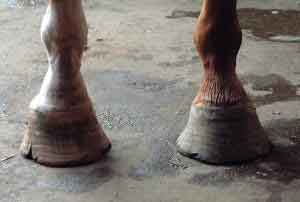 |
Big flares on very overgrown feet. This is a mechanical flare --
the walls have grown far beyond the sole, and the ground is "pushing up"
against the excess wall, forcing it away from the bone.
On the white leg, you can see a crack where the wall will break away as it self-trims. This horse, which does endurance racing, has a strong white line connection and apparently was not lame even with this much flare. |
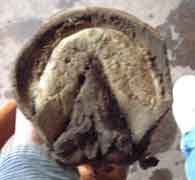 |
Sole view of the brown leg, above, showing overgrowth. One side has broken away at the quarter -- it's starting to self-trim. The other quarter is flaring a lot and will break away soon. The excess wall needs to be trimmed to the edge of the sole, and the bars to the level of the sole. Other than being overgrown, this is a nice, healthy foot. |
 |
A typical domestic hoof with a "pretty good" barefoot trim. Flare at the quarters (white arrow). Small groove where the white line is separated (black arrow).
This wall is trimmed to a flat bottom. The flare will disappear with a consistently applied mustang roll. |
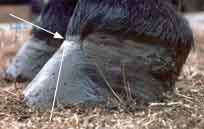 |
A chronic-founder type of flare. The horse foundered a year before,
due to laminitis, and nobody knew how to rehabilitate the founder. The
toe appears straight, but there is a bend in the toe angle just below
the hairline (arrow). I put a line following the direction of growth at
the top, showing where the new wall will grow when trimmed properly.
The heel has also gotten very long, typical in a chronic founder. |
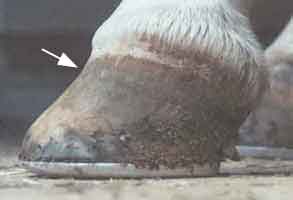 |
A mechanical flare due to overgrowth. Toe forced forward by the
combination of long heels plus the shoe.
Arrow points to the change in wall angle. This is where I believe the flare pain occurs -- where the white line is first being pulled apart. |
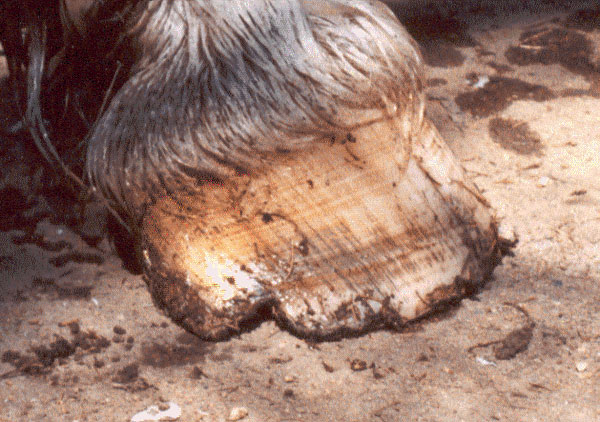 |
A draft horse, living on wet pasture without trimming, has trimmed
its own feet by flaring, cracking,and breaking off the wall. Looks awful,
but it works for the horse.
This is how wild horses living in the marshes of Europe trimmed their own feet. The hoof wall is thick, but soft, and breaks away easily. We would not ride a horse with feet like this. Before riding, we will shorten the wall to the level of the sole, and smooth the jagged edge on the wall with a good mustang roll. |
 |
Here is a foot where the toe has flared so that it's not a straight
line. I have marked where the toe should be, following the upper part of
the wall where it is well attached to the coffin bone and shows us the
correct angle. Where the toe sticks out in front of the line, the wall
has pulled away from the coffin bone and the white line is stretched; on
the bottom you would see a wide, dirty white line all the way around the
toe, and the hoof outline will be more oval than round.
This horse "has always had chronic laminitis" due to high-sugar grasses, and "always had oval feet." The owner asked for help for sore-on-gravel (see Transition page). I explained that the grass laminitis weakens the white line so that the toe flares more easily. Changing the diet (see www.safergrass.org) will be an important part of rehabilitating this foot, in addition to backing up the toe. |
 |
Here is another foot after a similar flare was rasped off. Also the edge has been rounded. |
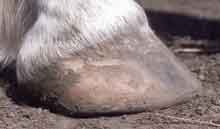 |
Here is a foot with no flare, showing the perfectly straight toe wall. The edge has been rounded (mustang roll). |
Mechanical flaring
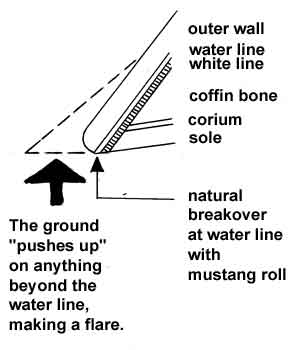 |
A cross-section of the wall, showing how a mechanical flare develops.
On a flat-bottomed wall, the ground forces the wall away from the coffin
bone. The white line separates, the coffin bone loses some suspension,
and the horse goes "sore on gravel."
To prevent repeated flaring, we will round off the bottom of the wall with a "mustang roll" (rounded bevel). However, every time the wall grows down to contact the ground, it will flare again, and you lose several weeks' growth of new white line connection. We need to renew the mustang roll weekly until the white line has completely tightened up and the flare is gone. |
For the immediate comfort of a flared foot, the top priority is to remove stress on the white line (see below) so that it is not painful and further stretching is prevented. Although the horse will be "walking on the sole" for a while, we see repeatedly that white line pain bothers horses more than sole pain. We can use protective sole pads for 2 or 3 days, if needed; after that, owners generally report that their horse is "running and bucking in the pasture."
In a transitioning horse, when the white line connection finally gets tight, three notable things happen:
- 1) Rather suddenly, from one trim to the next,
the sole will gain concavity as the coffin bone pulls up inside the
hoof capsule.
2) With feet that finally feel good, the horse is more lively.
3) The horse is able to walk on gravel, rocks, pavement, or frozen ground without pain.
The White Line Strategy
Pete Ramey originally figured out the "white line strategy"
as a way to get livery (trail-ride) horses back to work quickly after he
pulled their shoes. The idea is to remove flared parts of the wall from
ground contact so that the white line can grow down from the coronet without
re-flaring.
In this "transition" situation, the mustang-roll is applied all the way to the edge of the sole, rather than ending the roll at the (forward-flared) water line. When the white line tightens up (is no longer a groove or no longer dirty) which may take several months, then you can go back to a normal mustang roll, ending it at the water line.
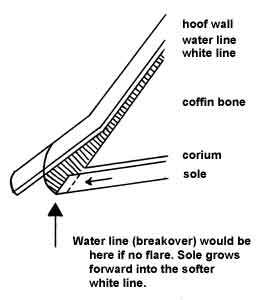 |
To rehabilitate a flare, mustang roll to the edge of the sole.
Renew weekly until the white line is no longer stretched.
When the white line has tightened up, use the standard mustang roll (maintenance trim), which stops at the water line. |
Many people write to me, concerned that their
horse's front feet are "flat." Yes, many front feet are less concave than they should be, due to farriers shortening the toe wall on the bottom, and thinning the toe callus, to make the foot more upright. Several months of the White Line Strategy trim, shown on my Do Trim page, will allow more toe length and sole thickness to grow.
Remember that normal front feet are noticeably less concave than hind feet. The front coffin bone has a shallower concavity so it can take a hard landing without cracking. On a draft horse, given how wide the foot is, a normal sole looks nearly flat. A truly flat
(foundered) sole is scary if you ever see one -- the foot looks like a block
of wood. You will know the difference!
Hind feet are more concave because the coffin bone is deeper. The hind feet are the horse's "engine" and the deeper hind concavity provides traction, like tractor treads.
 |
Here is the sole of a pony's front foot that has always been barefoot, except for one brief shoeing, showing true concavity. I watched this horse walk across sharp gravel like it was grass. Note the white "water line." The hoof was wearing evenly, and hardly needed to be trimmed. |
"White line disease"
In my opinion, most of what people are calling "white line disease" is not a disease but only a stretched white line, which can look strange and can be upsetting if you don't know what it is. The horse will be unsound -- by definition, a stretched white line is painful because it means there is a flare. In working with several hundred horses in the northeast USA, I have not yet seen a true case of white line disease and have not had to treat for it.
In true white line disease, fungus and/or bacteria become established in the stretched white line and travel far up under the hoof wall, destroying tissue. My understanding is that a hoof with white line disease sounds hollow when you tap it with a tool. The best treatment I have heard about is to soak several times with CleanTrax. (See the Fungus section on More Topics page.) Sometimes it may be necessary to cut away part of the wall to get air circulation to the diseased area. This type of treatment is beyond the scope of this website; I recommend contacting one of the more experienced barefoot trimmers / farriers for advice.
